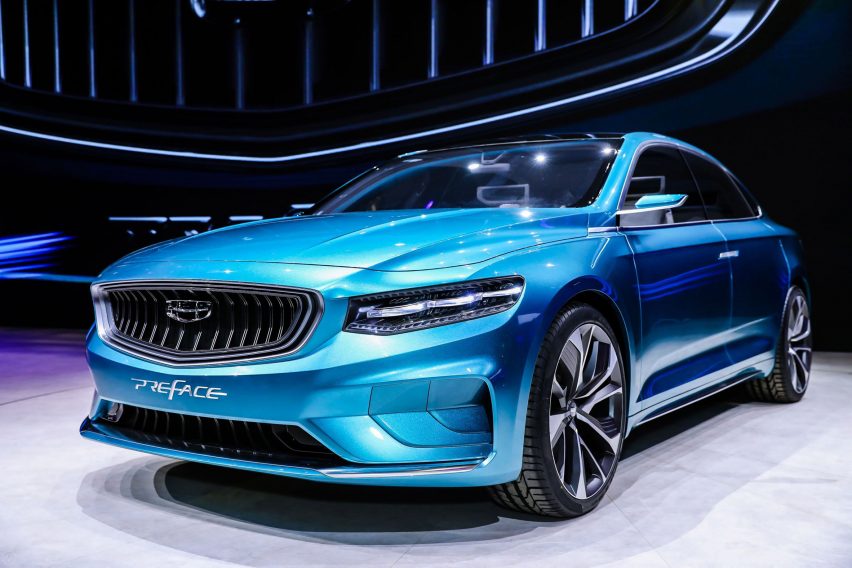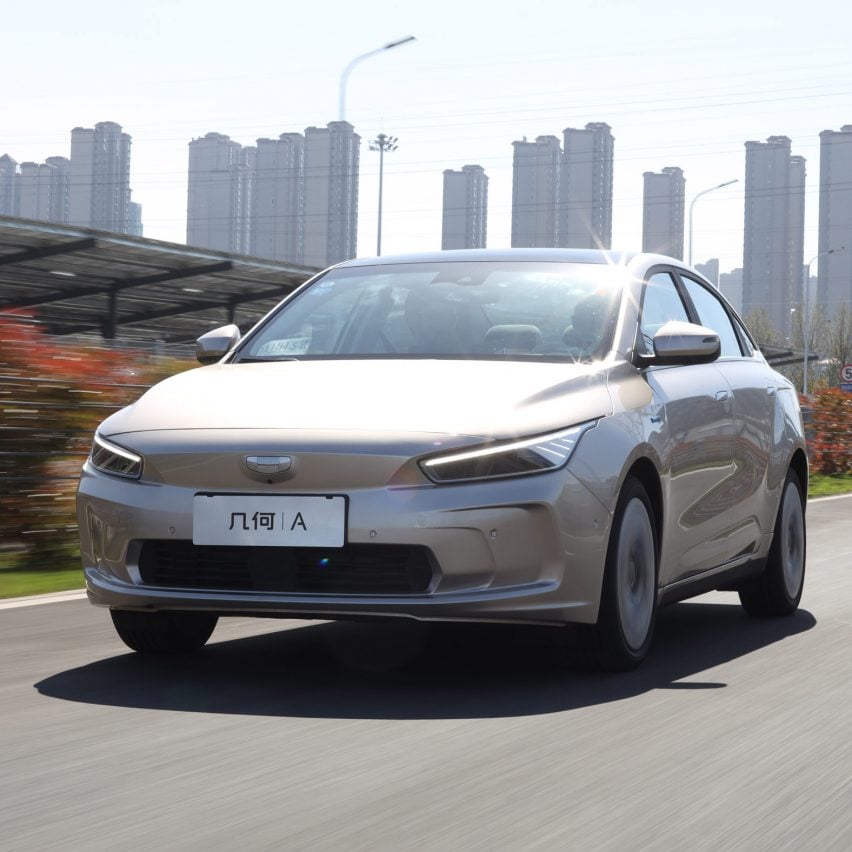
There is "no stopping" China's car design industry says Peter Horbury
Chinese car companies are putting their history of copying behind them and now have the confidence to create their own designs, says Peter Horbury, head of design for automotive brand Geely.
Although it has the world's largest car market, China's car companies are more known for heavily borrowing designs from foreign rivals. But that is changing as the country gains confidence in its own ability, claims British designer Horbury.
"[There has been] a bit of lack of inspiration and a bit of lack of confidence that in the last few years has been set free," Horbury told Dezeen. "There has been this release of creativity."
Horbury is global head of design for Geely, which is China's country's third-biggest car maker, and owns Volvo, Lynk & Co and Lotus.
He is widely known for his role as design director at Volvo, where he was responsible for the brand's revival in the 1990s. He was also previously head of Ford's Premier Automotive Group, which included Jaguar, Land Rover and Aston Martin, and then became design director for the Americas at Ford.
Horbury said had seen a large change in his six years at Geely.
"China is now quicker than Japan and becoming more confident with their own creations," he said.
"At the moment there is no stopping it."
Copying "more an honour than a crime" in China
In China copying is seen differently than in the west, with traditional methods of teaching relying on learning by repeating and understanding a master's training.
"If you copy the master you learn from the master, and copying is seen as more an honour than it is a crime, or a negative," said Horbury.
Attitudes are changing however, as is the law. The Chinese government recently ruled against a company accused of copying the Land Rover Evoque.
After several years of legal battles, the design of Jiangling Motor's Landwind X7 was deemed by a Chinese court in March to too closely resemble the Land Rover model, and production was halted.

Although copying of designs is prevalent in China, it is not something unique to the country, and it may be a phase within the development of a mature car design industry, said Horbury.
"Its not just China," he said. "I remember Japan started out by copying American cars, but smaller, and then European cars, and then came up with their own ideas."
Horbury claims that his own designs for Volvo were incorporated in the remodelling of the Nissan Micra.
He said that, when the car was unveiled during the Paris Motor Show in 2002, Shiro Nakumuro, then lead designer at Nissan, said: "You can thank Peter for those, I got those from the Volvo."
China "overtaking" other counties
The quality of design in China is being acknowledged around the world. Chinese designers have been chosen as guest of honour at numerous furniture fairs in the past year, while 62 projects from China were longlisted for Dezeen Awards.
The improving quality in the country means that China is set to leapfrog the west, according to Dezeen editor-in-chief Marcus Fairs.
Horbury is one of those who believes that this may have already happened.
"Its overtaking," he said. "You see the bravery of some of those cars, not just show cars, but the shock of some of those very striking designs on show today and yesterday from Chinese companies."
China is also pushing forward with the development of electric vehicles in a bid to reduce pollution in its cities and its dependence on oil.
Last year more electric cars were sold in the country that the rest of the world. The latest electric car designs from China were revealed last month at Shanghai Auto.
Future cars will have more Chinese cultural influence
The desire to copy is still not entirely absent from Geely reports Horbury, but as head of design he wants the company to find its own style.
"We still have senior managers come in meetings with their iPhones and say 'this Mercedes – can we have that?' No you can't. We'll do our own thing," he said.

Horbury believes that Geely will continue to develop its own style based on Chinese culture, and that foreign designers like him can help to shape it.
The next step for the company is to take Geely Auto branded cars to the global market.
"I would like to think that we will see more of Chinese cultural influence in the vehicle," said Horbury. "It often takes an outsider's pair of eyes to spot the things that are unique in a culture that you have all grown up with and didn't notice were different."
"Be proud to be Chinese, and show it," he added.
Read the interview with Peter Horbury below:
Tom Ravenscroft: How is China emerging as a design power?
Peter Horbury: I'm not a China expert, I've read quite a lot of Chinese history books and things. You know for two reasons I think that imagination was not a strong part of the culture in recent years.
Things were planned well ahead. But also – you'll have to correct me if I'm just making this up – in Confucius times the way of teaching and learning was that you learned from the master and you had to know just about everything the master knew before you could come up with an idea yourself.
Therefore this idea of copying, for example, to me stems from a bit from that. A bit of lack of inspiration and a bit of lack of confidence, that in the last few years has been set free. As the chairman [of Geely] said about Volvo, "set the tiger free into the mountains". Its been like that here, there has been this release of creativity.
For example, the first science-fiction movie that I have ever heard of was launched a couple of months ago. There was no such thing as science fiction, because imaging the future was unnecessary. So that is key to the explosion of freedom to think, to imagine and to create.
Tom Ravenscroft: What was the trigger for all that?
Peter Horbury: The internet has opened up things, and the use of technology is number one here. Everyone knows how to use it and knows how to find out what they can find out. So I think that spread of information has been key.
Tom Ravenscroft: In the car industry Chinese companies have been known for copying designs, but recently in the Evoque case the Chinese government sided on the side of Land Rover. How has this culture changed since you arrived at Geely six years ago?
Peter Horbury: It was very insular. And as I say the Evoque incident was down to either, or maybe both, the fact that if you copy the master you learn from the master, and copying is seen as more an honour than it is a crime, or a negative.
Its not just China. I remember Japan started out by copying American cars, but smaller, and then European cars, and then came up with their own ideas.
Tom Ravenscroft: Where is China on that trajectory?
Peter Horbury: China is now quicker than Japan and becoming more confident with their own creations.
I was on the show stand at Nissan in Paris, I think it was, and the Micra [third generation K12] was there – the first Micra with shoulders running down the side. And Steve Cropley [currently editor in chief of Autocar] was with us, we were just having a chat.
He said: "I have to say, I really like the Micra. The shoulders down the side look really strong."
Shiro Nakumuro [then lead designer at Nissan] said: "You can thank Peter for those, I got those from the Volvo."
And I was like: "You what?"
Of course I should be honoured about it. So there is a different culture about imitation. Its the sincerest form of flattery.
Tom Ravenscroft: How has the industry gone from that – copying being an honour culture, to wanting to create its own designs.
Peter Horbury: For one thing hiring people like myself, who have a completely opposite viewpoint on copying. We still have senior managers come in meetings with their iPhones and say "this Mercedes – can we have that?" No you can't. We'll do our own thing.
One of the reasons we didn't want to do that is that they were about to be selling an old vehicle [Jiangling Motor Corp's Landwind X7, a copy of the Land Rover Evoque]. In this case the Evoque didn't change too much, but it did change. So what they end up with after three years of developing something they have seen in a Land Rover dealership – they are now sitting on an old version of the car.
So that's one of the reasons we don't. If somebody – one of the management – says I really like this front of a Merc or something, well that's today. We're not in the business of today, we are in the business of tomorrow.
Tom Ravenscroft: You said yesterday that China has stopped catching up but has caught up...
Peter Horbury: Its overtaking. You see the bravery of some of those cars, not just show cars, but the shock of some of those very striking designs on show today and yesterday from Chinese companies. I'm not saying the entire design team are Chinese. But as time has gone in the last few years, the freedom to create for the western designers working there, the expectation for new has grown.
Tom Ravenscroft: And how do you think this progresses into the future?
Peter Horbury: I would like to think that we will see more of Chinese cultural influence in the vehicle. When I was at Volvo it took an outsider, and I told them this, it often takes an outsider's pair of eyes to spot the things that are unique in a culture that you have all grown up with and didn't notice were different.
So we started being confident in using design languages from Swedish furniture – the bent wood, for example, on the side shoulders of the Volvo is straight from chairs.
And then when I went to America, they were in a period of, I wouldn't say they were ashamed of being American, but it was not that positive. I said for God's sake you guys.
This was translated into the front end of the Ford. One thing about Americans is that you have great teeth. I have to go around saying I'm terribly sorry I'm English.
So why not show it. The front of the Ford on the Escape and others – the SUVs – we just went for it. And it was proud to be American, Let's be American. We are not selling these cars in Europe, they are America-only pick-up trucks and SUVs.
We actually did a picture plate to a song by John Meloncamp called Pink Houses, and the chorus line is: Ain't that America. We showed this – it wasn't a movie, it was still pictures, but in time to the music – with American landscapes and American people, because the song was perfect for it.
And at the end of the four minutes the picture came up with a country road in America going into the sunset, distance, telegraph poles with the wires hanging between them and in red it said: One American Road. And above it the Ford Motor Company and below Dearbourne, Michigan. Because One America Road was the official address of the Ford Motor Company. With an address like that, how could we fail.
We showed this to 500 people and one bloke with a silk jacket with blotches, stains on, came up and said: "you see that? They're tears. Thank you."
Tom Ravenscroft: How does that translate to China?
Peter Horbury: It was me, an Australian, a Dutchman and one American – I can't remember the other nationalities – but five of us put this thing together. Sometimes it takes an outsider to tell you who you are.
We are able to spot those things, whether it is the promotions of a window or the angles of a roof, the eaves on a building. These sort of things that are natural to local people we see that they are not like Sweden, they are not like America, can we make something of that in the way we design.
Tom Ravenscroft: What is the next step for Geely?
Peter Horbury: My philosophy for designing cars is if you can capture some of the local visual culture, then you can create something unique and desirable from that country. Italian cars should only look like they can come out of Italy and French cars... Citroën in the 1960s had the DS. Then in the 1970s and 1980s they just lost it with the BX and all these humdrum cars. Then more recently they suddenly got it back. Citroën became Parisian chic again.
Using that culture can really make an attractive product.
Tom Ravenscroft: And is the aim to sell Geely outside of China?
Peter Horbury: Yes. Be proud to be Chinese, and show it.
Tom Ravenscroft: What next for the Chinese auto industry?
Peter Horbury: As technology increases in China at a fast pace, I think the ability to create designs which are dependent on the new way of forming material will come through. At the moment there is no stopping it – the Chinese designs and technology.